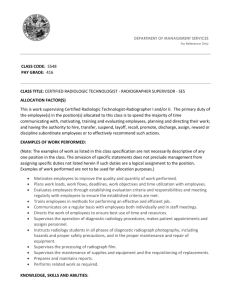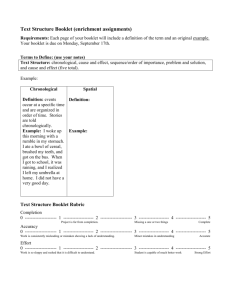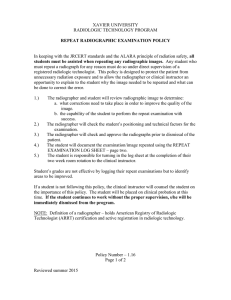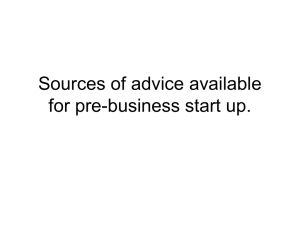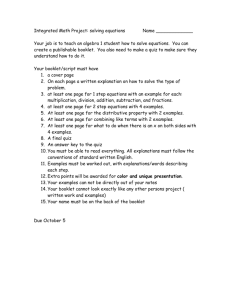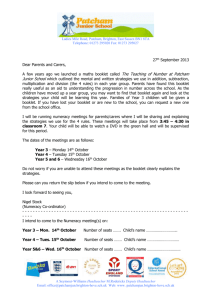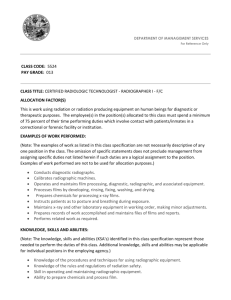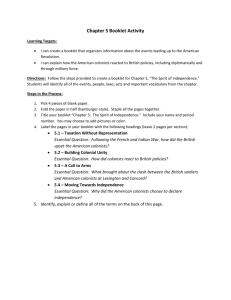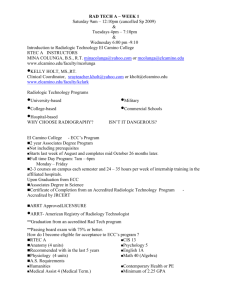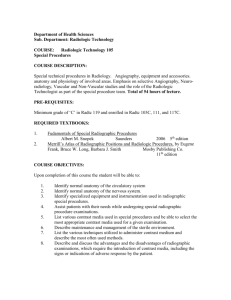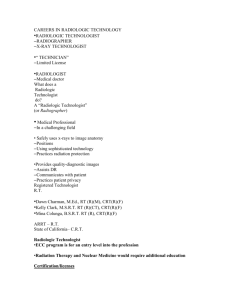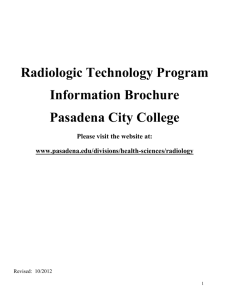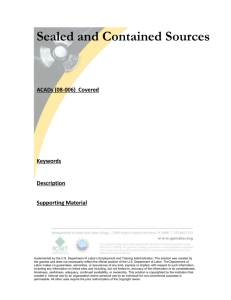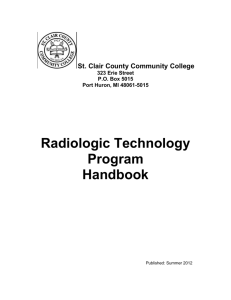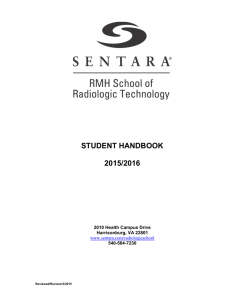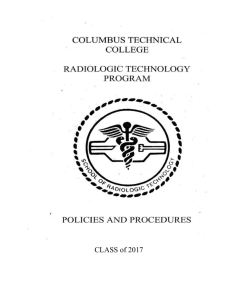Guide to Performing a “General” Patient Inspection
advertisement
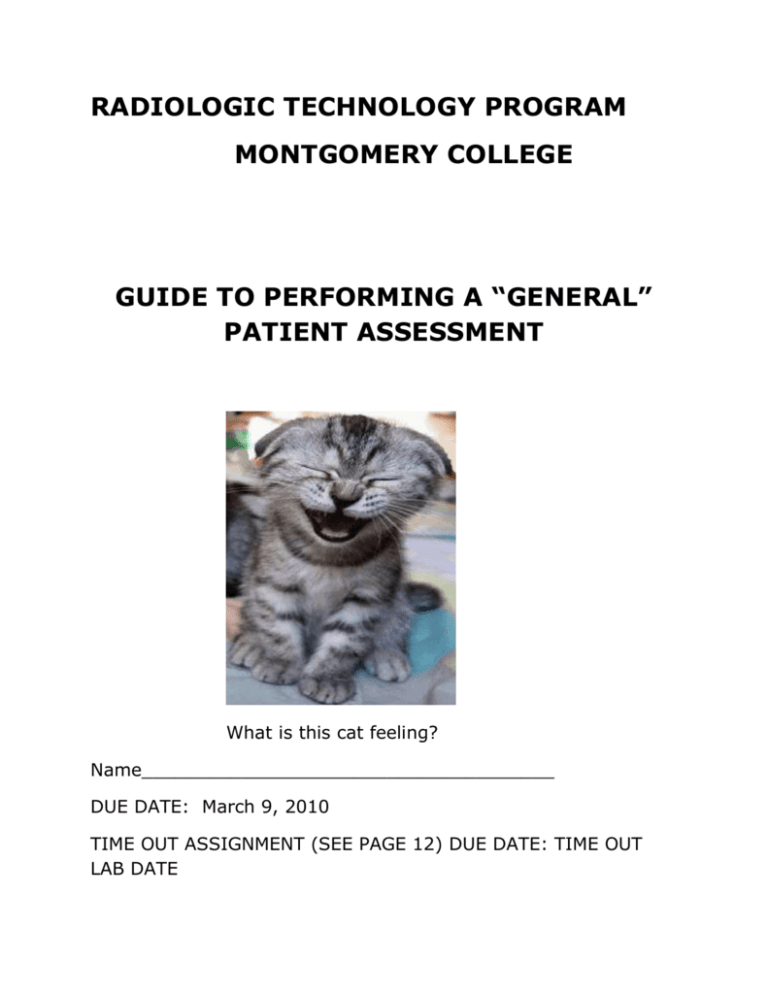
RADIOLOGIC TECHNOLOGY PROGRAM MONTGOMERY COLLEGE GUIDE TO PERFORMING A “GENERAL” PATIENT ASSESSMENT What is this cat feeling? Name_____________________________________ DUE DATE: March 9, 2010 TIME OUT ASSIGNMENT (SEE PAGE 12) DUE DATE: TIME OUT LAB DATE Montgomery College Radiologic Technology Program RT 102 Patient Care Assessment Purpose: To support patient care objectives first reviewed in RT 119 Outcome: improved patient care methodologies when performing radiographic procedures Directions: Students are to complete this patient care booklet by answering questions as they relate to patient care objectives. Students should refer to the Patient Care in Radiography book by Ehrlich and can also use reputable sources via the internet and/or other textbooks. The student’s written responses to the questions must be typed and placed within this booklet either on the next page identifying the question they are answering or on the same page. Students are encouraged to critically think as to how they would handle the scenarios and questions in the booklet. This means that if a student is confident they have a good solution to the question and do not feel they need to refer to the book, the student is encouraged to provide this answer. The instructors are looking for thoughtful thorough analysis of the questions and assessment of scenarios. The booklet is to be completed and handed in on March 9, 2011. Upon review, if answers are considered incomplete, the student will be asked to review those answers and resubmit the booklet by April 27, 2011. Successful completion of the booklet will result in a grade of 100%. The Time Out Lab, which is mandatory, requires the student to complete a small assignment prior to the lab and the student must bring this assignment for evaluation to their Time Out Lab as this is part of the lab schedule .This assignment can be found on page 12 of this handout and is a SEPARATE assignment from the booklet. This assignment must also be typed. Failure to bring this assignment in will result in a zero for the lab day. Students are reminded that this is an individual project and therefore the answers should be recorded in each student’s own words. 2 Guide to Performing a “General” Patient Inspection (Initial Patient Assessment) Gather patient information before entering room: Information from patient requisition, chart and or a prescription Admitting diagnosis Past Medical History (PMH) Past Surgical History (PSH) Medications that patient has taken or been given Communicate with clinical instructor if you have any questions or concerns WHY SCENARIO A radiographic examination of the pelvis and right hip is ordered on an outpatient male is ambulatory but uses a cane with assistance. The only information on the requisition was the patient came in after a fall. In terms of obtaining the best radiograph why is it important to obtain the patient’s past medical history, past surgical history and any medications he may be using. Speculate on what adjustments you would make if the patient indicates prior pelvic issues. Review Chapter 3 in Patient Care in Radiography Answer Critical thinking exercises 1-5 on page 97 3 Upon entering the room with the patient: Wash hands immediately before entering patient room and put gloves on Introduce yourself and check patient’s identification bracelet Explain to the patient what you will be doing throughout the exam Remember to always provide privacy Obtain Patient’s History or Reason for Exam : 1. What is wrong? 2. What are patient’s symptoms? 2. Duration 3. What makes it better? 4. What makes it worse? 5. LMP, if female When you are ready to leave the room for the first time be sure to thank your patient for allowing you to participate in their health care WHY SCENARIO Why is it important to make an assessment of the room you will be taking the portable in? What sorts of observations once you enter the room will give you information as to how to best obtain the radiograph without compromising patient safety? Review Chapter 6 in Patient Care in Radiography Answer Critical thinking exercises 1-3 on page 221 4 Before leaving the patient alone in the room: Scan room before leaving: make sure patient is safe and has everything he/she needs within reach: call light, phone, etc. make sure bed is in lowest position & side rails are up WASH YOUR HANDS Communication: Use appropriate patient communication techniques During your “Patient Interview” identify patient concerns and goals, & chief complaint, ask yourself: What should I focus on when providing care to this patient? Communicate to your patient the desire to help in any way possible 5 QUESTIONS Hint: The General Inspection (Assessment) begins the moment the technologist enters the room with the patient. Be observant: 1. Physical Appearance & Hygiene What information can you gather about the patient by observing the patient? Be specific about the physical appearance, vital signs, other observable physiological conditions. 2. Body Structure and Position What information can you gather about the patient regarding habitus and posture/position. What information does the patient’s body’s posture or position give you in terms of pain, mobility etc? 3. Body Movement How can you assess this? How do involuntary movements inform you as a radiographer and how would you accommodate this issue and still obtain a radiographic image. What does “guarding an extremity or a movement” mean and what impact does that have when positioning a patient? What clues will you tell if a patient is in pain when moving or lying still 6 4. Behavior, Emotional & Mental Status WHY SCENARIO A radiographer, after assessing the patient has indicated that the patient seems a bit confused and does not seem to want to answer questions. What non-verbal cues from the patient may have provoked this assessment? . What assessments can a radiographer make to assess behavior, emotional and mental status and why is this important? How would you adjust your patient care strategies to accommodate a patient demonstrating behavior, emotional or mental challenges? 7 NEUROLOGICAL SYSTEM LOC (level of conscious) Orientation Ability to follow commands Speech Hearing Vision Sensory aids INTEGUMENTARY SYSTEM SKIN for: Lesions, rashes Color, temperature Texture,moisture,turgor Bruises,Wounds, Incisions Drains (type, location, Drainage) Dressings (drainage) GASTROINTESTINAL SYSTEM RESPIRATORY SYSTEM Respirations for: Rate, Rhythm, Depth, Symmetry Pulse Ox. Skin Color SOB (Shortness Of Breath) Breath Sounds Cough (dry or productive), strong or weak Sputum (color) Oxygen: O2 / Room Air Nausea, vomiting Oral mucosa Abdominal pain, distention Last BM (any changes), bowel habits, pain or difficulty with defecation Diarrhea, Constipation Bowel Sounds (normal, hyperactive, hypoactive) Presently taking stool softners or fiber supplements 8 GENITOURINARY SYSTEM (Reproductive System) Urinary Pattern (frequency, urgency, hesitancy, incontinence, change in urine stream) Painful urination (dysuria) Flank pain, pain, lesions Blood in urine (hematuria) Urine characteristics: color, clear, odor, sediment, clots Discharge Females: LMP, abnormal menstrual cycle 9 10 Refer and read the article-(see page 10) A Patient Centered Care Model. ASSINGMENT: Assessment of the patient is not noted on this model. Add circles from the patient circle to include information that assessment of the patient would provide. 11 TIME OUT LAB Outcome: using a simulated environment, students in groups of four will have an opportunity to participate in a portable study. Students will then debrief and share assessment of their performance, emphasizing the patient care component of the simulated examination. Students will sign up for one of the following Friday Labs Time 9:30-12:30 February 4 February 25 April 1 April 29 May 6 Students MUST bring to the lab the attached TIME OUT Assignment as prior to the simulated lab, the assignment will be reviewed and discussed. Failure to complete this assignment will result in a zero for the lab grade. Assignments must be typed the answers do not need to be submitted in complete sentences. TIME OUT LAB schedule 9:30-9:40 Review homework assignment. 9:40-10:30 Live scenario participation 10:30-11:30 Sim Man Scenario (HC 341) 11:30-12:30 Debrief 12 RADIOLOGIC TECHNOLOGY PROGRAM MONTGOMERY COLLEGE TAKOMA PARK/SILVER SPRING CAMPUS RT 102 TIME OUT ASSESSMENT (information based on Chapter 6, Erlich) DUE ON THE DAY OF THE TIME OUT LAB 1. What are some signs to look for that may indicate that a patient is in respiratory distress? 2. How do various respiratory or cardiac conditions affect your technique? Also, what methods may be used in obtaining an adequate chest, abdomen radiograph without motion? 13 3. Review in your patient care book any methods that help you obtain a blood pressure reading. Indicate the range for a normal blood pressure. 4. What is a normal respiration range for an adult and how do we obtain a respiration count? 5. What information does a cardiac monitor provide to us? It is important for the radiologic technologist to recognize a few of the configurations that may be life threatening situations? What does a normal ECG waveform resemble? Explain the various parts of the graph. Explain what happens during bradycardia, tachycardia and PVC’s and explain how the patient may feel. 14 6. What are pleural vac(chest tubes) used for, why must we be careful around them? What can happen with the tubing and the box during a portable exam? 7. If patient is diabetic and complains of being weak or is hungry and asks for food and has taken their insulin, what should your response be? 15
